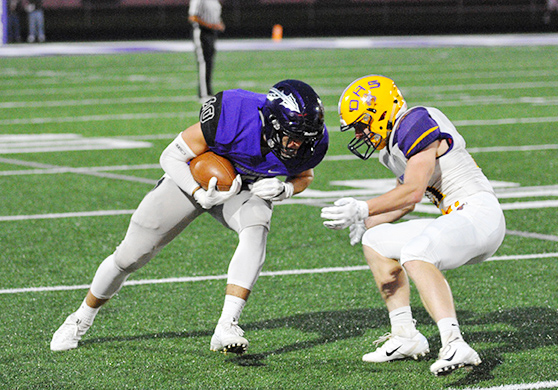Football: Drills to develop man coverage skills for defensive backs
Man-to-man coverage begins with the proper alignment of the defensive backs to the receivers at the line of scrimmage (LOS). This normally places the corner backs 5 to 7 yards off of the LOS, with an inside shade on the receivers. At the snap of the ball, the defensive back must maintain that inside advantage throughout the play.
The strong (SS) and free safety (FS) alignments depend on the following factors: offensive formation, down and distance, field position, field conditions, score, and time remaining.

The use of the following daily drills allows DBs to develop the skills necessary for man-to-man coverage. There is a great variety from which to choose for developing the young DBs, although the same stances are used in both man and stance coverage.
The Wahconah High School defensive backs assume their relaxed stances with flexed knees and hips, knees over the toes, nose over the knees, chin up, eyes are fixed upon the receiver’s inside hip, and back slightly arched with the front numbers visible on the LOS.
The backs hold their hands numbers high, elbows flexed at 90 degrees, and the inside foot kept closest to the LOS. At the snap of the ball, the backs step backward with the outside leg, allowing them to maintain their inside advantage as they read the receiver’s route. If the receiver breaks inside sharply at the snap, the DB reacts on his second step as his inside foot touches the ground.
It’s important for the coach to properly demonstrate each drill and technique for the young DB. This builds credibility between coach and athlete, while boosting the athlete’s confidence in his ability to perform every task.
It’s assumed that the coach demonstrates all of the following drills and skills, then has the backs perform all of the drills, beginning as a walk through and progressing to a quicker pace as the athlete’s skills improve. Perfection is the key to a successful DB. All new drills should beginning as a walk through and progressing to a quicker pace as the athlete’s skills improve.
Give them as many reps as time allows before going on to the next drill. Not all drills are used every day or throughout the entire season. Pick and choose what is best for your situation at any given time. If a ball is added to the drill before technique is mastered, the athlete will not develop the skills necessary to be successful in game situations.
Footwork
All of the footwork drills should be done in a confined area of the practice field, performed from the left and right, to allow the coach to observe the technique of each athlete. These drills are not intended to be used for conditioning, so backpedaling should be limited to no more then 10 yards so the DB can react to the coach’s command.
DRILL 1: Check the stance. Improper stance doesn’t allow the DB to use proper mechanics and will not be effective in man-to-man coverage.
The drop-back technique used at Wahconah is common to most football programs. At the snap of the ball, the back must step with his outside foot while keeping his eyes fixed on the receiver. As the DB continues his back-pedal, he must pump his elbows behind him, keeping them flexed at 90 degrees.
The knees and nose must stay over the toes, his chin level with the ground, and his back arched. The DB must lift his toes just high enough to avoid scraping the top of the turf while reaching backward with each step.
DRILL 2: Drop-back technique. After establishing a proper stance, the coach must demonstrate proper drop-back techniques for man-to-man coverage. Beginning with his outside foot, the coach must demonstrate the proper drop-back technique, aligning three to four athletes side-by-side, 5 yards apart.
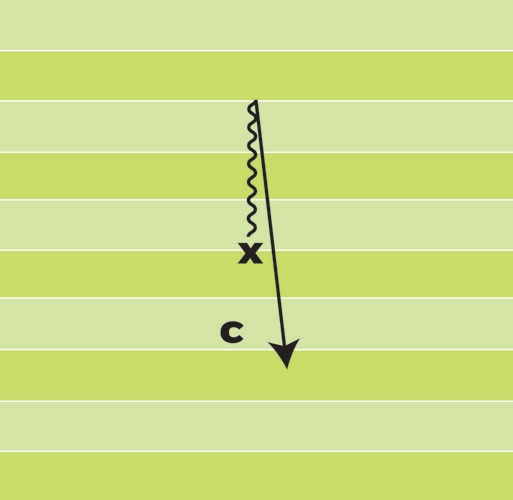 |
| Drill 2 |
On the coach’s signal, the DBs begin to back-pedal. On the coach’s next command, the DBs must use a bicycle-step technique to return to the LOS, along the same path they back-pedaled.
Angle drills
The DB can get out of his back-pedal from a variety of different angles as the play develops. The following drills teach DBs how to do that. Each drill can be done independently or combined into one drill, which we call the Star Drill (illustrated at the end of the article).
DRILL 3: Defensive backs back-pedal on command. The coach indicates which direction the DBs should redirect to. On command, the backs use a bicycle step to redirect at a 45-degree angle toward the LOS and run through the LOS.
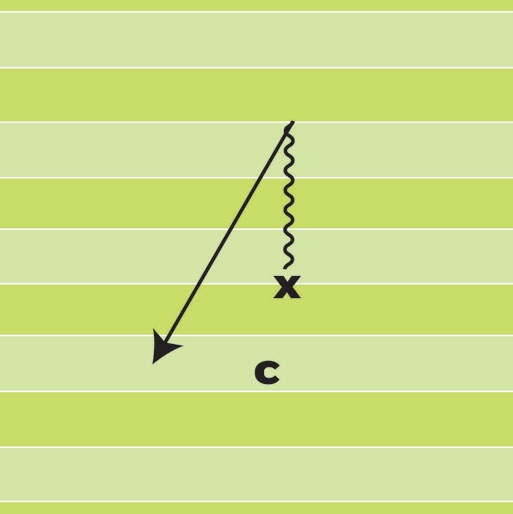 |
| Drill 3 |
DRILL 4: Defensive backs back-pedal on command. The coach indicates which direction the DBs should redirect to. On command, the backs redirect, using a bicycle step, at a 90-degree angle, and sprint 5 yards through the LOS.
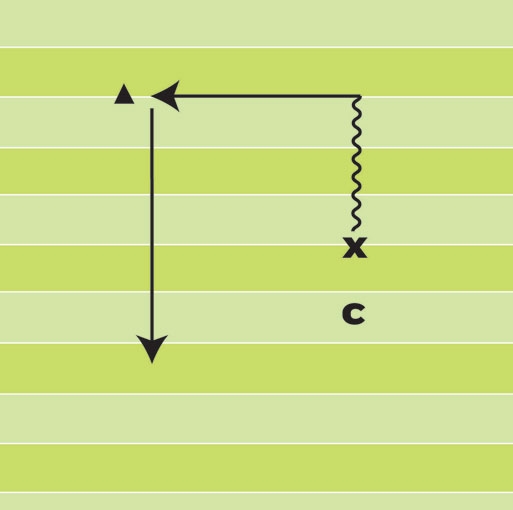 |
| Drill 4 |
DRILL 5: Defensive backs back-pedal on command. The coach indicates which direction the DBs should redirect to. Upon command, the backs must use a bicycle-step technique to turn 45-degrees away from the LOS, sprint 10 yards, and touch a cone placed on the field.
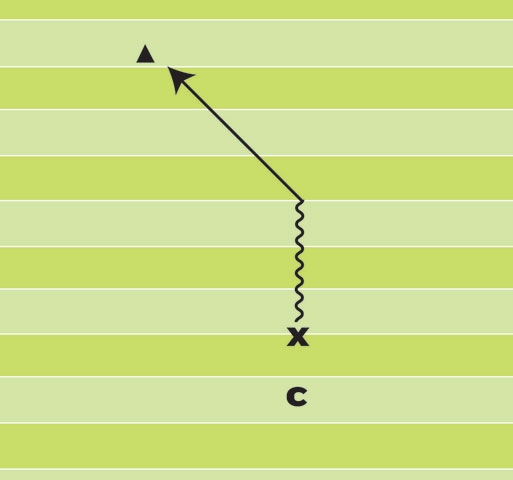 |
| Drill 5 |
DRILL 6: Defensive backs back-pedal on command. The coach again indicates which direction the DBs should turn to. On command, they are expected to execute a speed-turn technique for a 180-degree turn and then sprint 10 yards to touch a cone placed on the field.
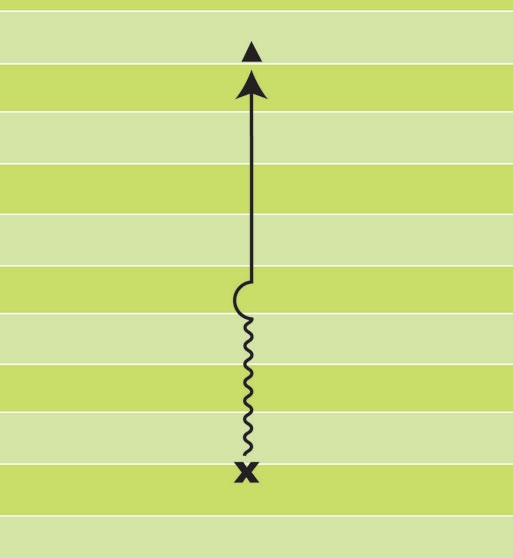 |
| Drill 6 |
Playing the man
The following drills are introduced to the DBs after they have perfected Drills 1 through 6.
In playing man-to-man coverage, DBs must be able to determine what the receiver is going to do before the receiver actually does it. To do this, the backs must “read” the receiver. At the snap, the DBs focuses their eyes on the inside hip of the receiver.
Where the hip goes, the DB goes. If the hip moves up field, the back continue his back-pedal movement. If the hip moves inside, the DB stems inside to keep leverage. If the hip moves to the outside, the back keeps his inside leverage and begins to press the receiver toward the sideline, not allowing the receiver to break back inside.
Thomas Kearney, a former assistant coach at Iowa Wesleyan College, has several drills for teaching how to read the receivers’ intended pass routes. The three following drills are based on an article he once published in Coach & Athletic Director. They are modified somewhat to fit the needs at Wahconah High.
DRILL 7: The 45-degree break. With his eyes focused on a receiver’s inside hip, the DB (with inside leverage) aligns 3 yards off the receiver. On command, the DB and receiver begin to back-pedal, with the receiver breaking at a 45-degree angle toward the LOS.
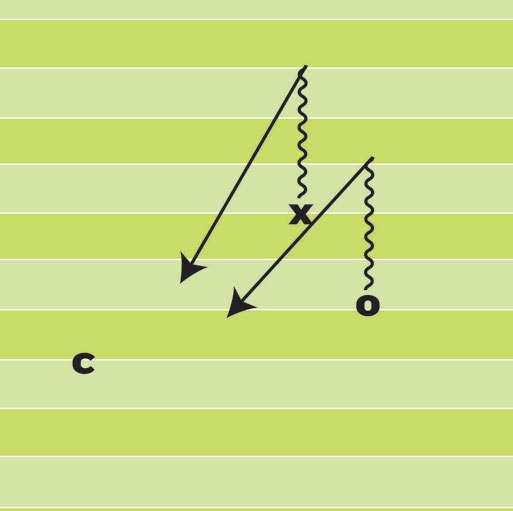 |
| Drill 7 |
The DB has to recognize the break and redirect to make a play on the ball thrown by the coach. If the DB cannot make a play on the ball, he must be in position to tackle the receiver.
DRILL 8: The 90-degree break. As in Drill 7, the DB focuses on the inside hip of the receiver. On command, the receiver back-pedals and then breaks at 90 degrees.
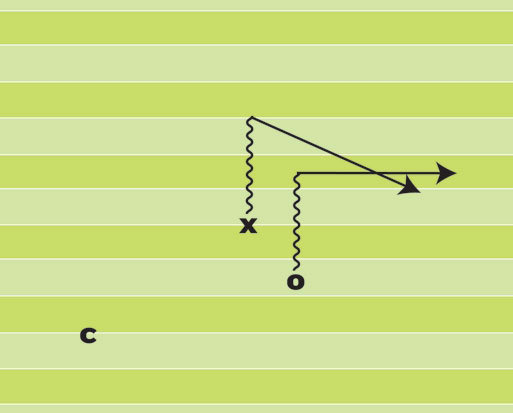 |
| Drill 8 |
The DB must recognize the break and redirect to make a play on the ball. If he cannot make a play on the ball, the DB must be in position to tackle the receiver.
These drills can be adjusted by simply changing the angle of the receiver’s break. We use this drill six times to replicate the Drills 2 through 6. We also make sure to have the DB execute the proper footwork for each drill.
The next step to assure recognition for man-to-man coverage is to place the DB in his proper stance and alignment opposite a receiver. On command, the receiver must run a pre-designated route, which the DB must recognize and defend by using the skill developed through the previous drills.
The routes I most often use for drill work are quick slants, 5 and 10-yard in/out routes, 10-yard inside/outside comebacks, post, and fly. During the season, I adjust the routes to what is expected from each opponent.
Press coverage
When aligned in press coverage, the DB must be 1 yard off the LOS and 1 yard inside the receiver, with his eyes focused on the latter’s inside hip.
The DB’s inside foot must be placed closest to the LOS, with his outside foot back. He must be angled 45 degrees from the LOS so he can take away the inside path of the receiver. The hips are kept low with a knee bend of almost 90 degrees. Knees, chest and nose are over his toes, and the chin stays level with the turf.
At the snap of the ball, the DB takes a 6-inch forward step with his inside foot and punches with his inside hand to the inside shoulder of the receiver. If the receiver tries to run inside, the DB shuffle-steps inside and punches to the receiver’s numbers with his outside hand, forcing the receiver to run up field or to the outside. From this point, the DB must play a reverse cushion technique to defend against the route.
I use the following drill to develop this reverse cushion technique for man-to-man coverage.
DRILL 9: Defending the slant route. Place a DB opposite a receiver in the proper press position, and on command have the receiver attempt to run a hard slant to the inside. The idea is to keep the receiver from crossing the DB’s face and running the inside route. If the receiver succeeds, we want our defender to punch the opponent’s upfield shoulder, forcing him to run flat along the LOS.
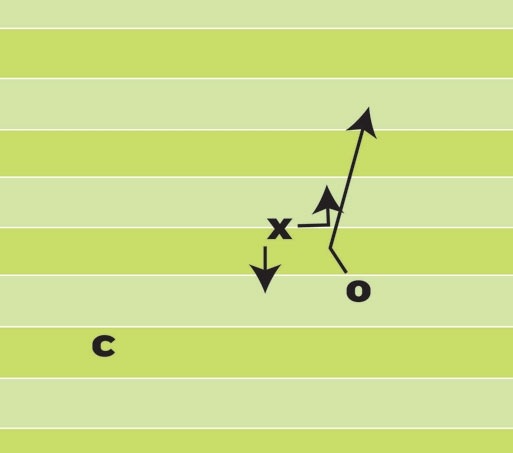 |
| Drill 9 |
DRILL 10: Defending the 5- to 10-yard in route. The DB is once again in a proper press technique. As the receiver attempts to run upfield, the DB punches and steps with his inside hand and foot.
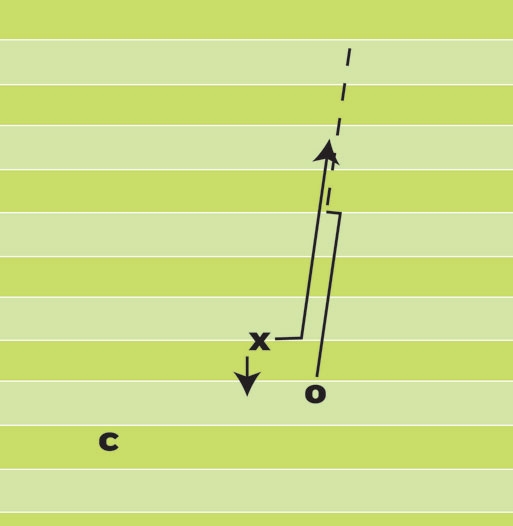 |
| Drill 10 |
On his second step, the DB turns into the receiver and places his inside hand on the receiver’s hip and runs hip-to-hip with the him, preventing the receiver from running the inside route. The DB’s eyes are now focused on the receiver’s ear-hole.
DRILL 11: Defending out routes. To defend out routes, the DB must take the proper press alignment on the LOS. He must use the same techniques as in defending the in route.
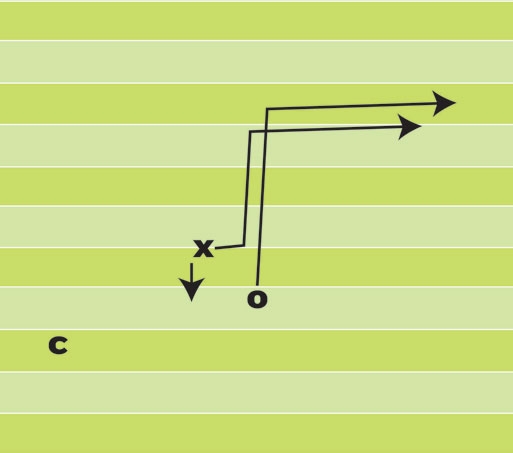 |
| Drill 11 |
As the receiver attempts to break to the outside, the DB feels a separation of the hip from his hand. At this point, the DB sinks his hips to redirect to the outside, putting him underneath the receiver and in position to make a play on the ball.
DRILL 12: Reverse cushion. Place the DB in the proper press position opposite a receiver. On command, have the receiver take a stutter step to the inside, as if attempting to run a quick slant, but instead, have him run a deep fly route.
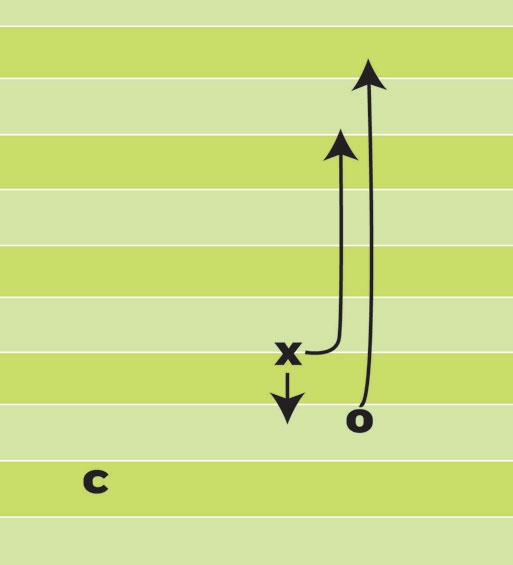 |
|
Drill 12 |
The DB must punch and step with his inside hand and foot to prevent the quick slant. If the receiver separates to the fly route, the DB must play the reverse cushion technique.
With his hand on the receiver’s hip, the DB should turn into the receiver and attempt to maintain contact with his hip. The DB’s eyes should now be focused on the receiver’s ear hole. If the DB loses contact with the hip, he must make every attempt possible to close the distance between himself and the inside hip of the receiver, while always keeping his eyes on the ear hole of the receiver’s helmet.
As the receiver turns his head to look for the ball, the ear hole disappears. The DB must then focus on the eyes of the receiver. If the eyes get bigger, the ball is coming. At this point, the DB must look for the hands of the receiver. As the hands go up to catch the ball, the DB must place his hands inside the receiver’s hands.
The DB must then turn his head and make a play on the ball. If he cannot place his hands inside the receiver’s hands, the DB must either rake down on the receiver’s arms or punch up between the hands to take away the football. If he cannot secure the football, he is in position to make the tackle.
These are some of the drills and skills taught for DB man-to-man coverage at Wahconah. They are intended to give all of the DBs the opportunity to develop the skills needed to play 1-on-1 football with a pass receiver.
As the athlete’s skill progress, adjustments should be made to make the training more specific to each player’s defensive backfield position.
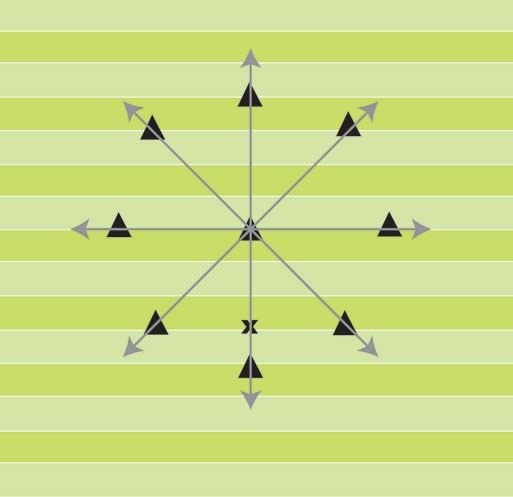 |
| Drill Star |


